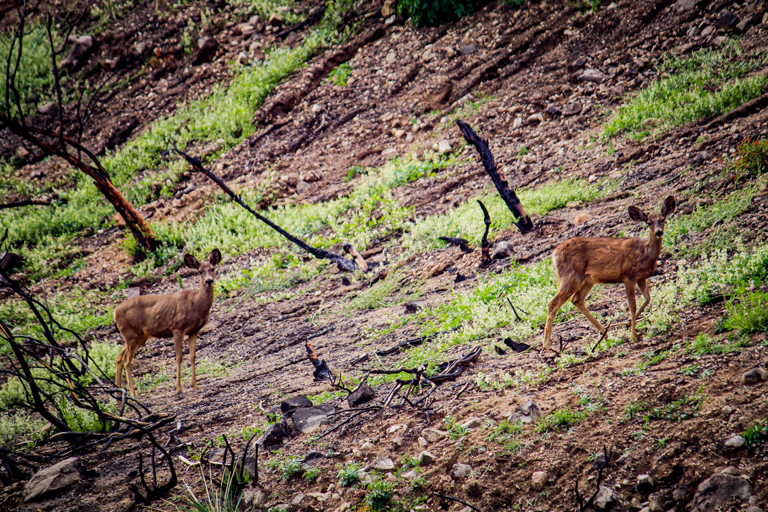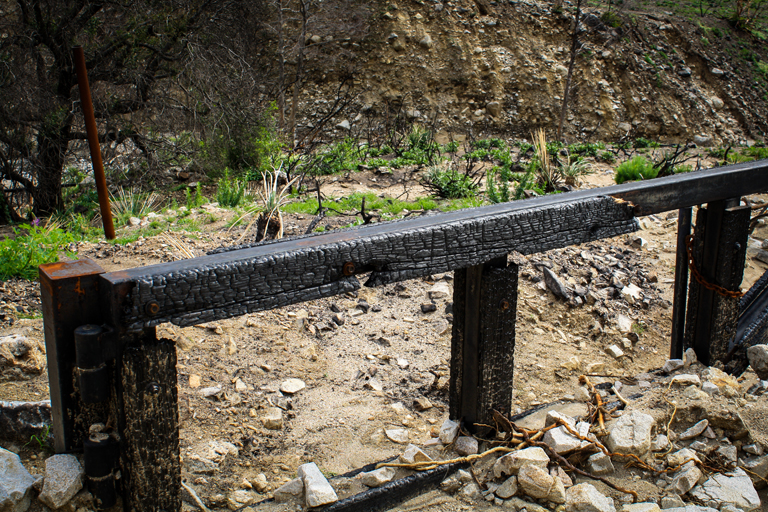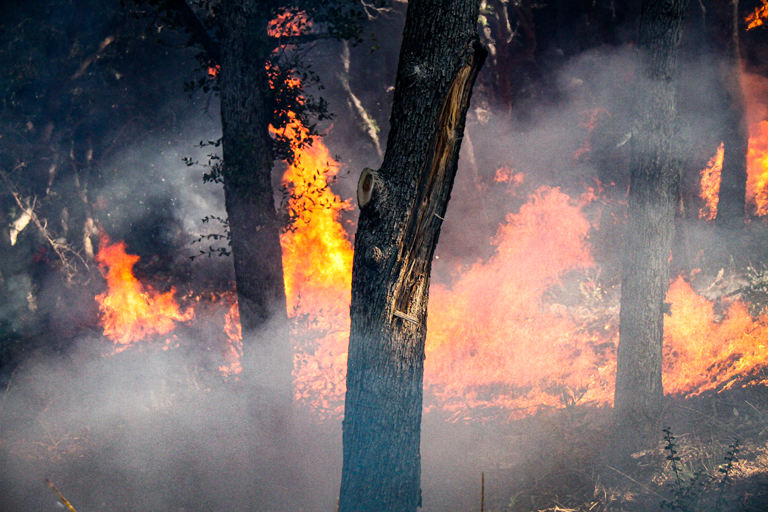
Two deer find their way back to Deukmejian Wilderness Park in February 2010 after the Station Fire decimated the area.
By Mary O’KEEFE
California is no stranger to wildfires. Each year, thousands of acres burn across the state with crews battling to save homes and wildlife in arduous conditions. But California has never seen anything to the extent of the wildfires currently ravaging Australia. The total burned area in the Australian wildfires would stretch from Bakersfield to San Diego and from the Arizona state line out to the coast, all at once. And while Los Angeles hasn’t seen that extensive damage, those who have lived through some of the worst fires here can relate to and remember what it was like … and want to do something to help.
CV Weekly reporter Charly Shelton was photographing the front lines of the Station Fire in 2009 when it burned 160,577 acres of wilderness and numerous homes.

“I remember everyone was there for the flames,” Shelton said. “There was constant news coverage while it was on fire but, after that, what happens? The land is all scorched, it looks like a moonscape. Animals that ran from the fire come out of their hiding places to a world without food, without water, without shelter. It took a while for the land to bounce back. It felt like none of the larger news outlets cared except us at CV Weekly and Glendale NewsPress.”
He traversed several hills and valleys, along with other local media photographers, as they were updated on the results of the fire. But Shelton sees the aftermath of the fire through the lens of both a reporter/photographer and a scientist. Shelton is a working paleontologist.
“In paleontology, I am used to seeing strange animals that have gone extinct. I don’t want to see that happen with animals that I have had a chance to see in real life,” he said.
The repercussions of wildfires are deep, and include the loss of human life, homes, ecology and the profound loss of thousands of wildlife.

Shelton added the loss is more dramatic than just a few animals that have been burned but instead there are consequences faced by entire species. This is especially true in Australia where estimates are 1.25 billion animals were lost in the blaze and the resulting aftermath of lack of resources.
Over 25 million acres, or 32,400 square miles, of land have been burned in the Australian wildfires so far this season. Within that 32,400 square miles were countless animals already in danger from a changing landscape of human interaction and climate change. Generations of humans hunting these animals for their pelts reduced their populations to staggeringly low levels. Koala populations, for instance, have dropped by 95% between 1788 and 2010 due to deforestation and hunting. Last May, a letter from the Australian Koala Foundation to Australian Prime Minister Scott Morrison reported that there were only 80,000 koalas left in Australia. This made them “functionally extinct” because there are no longer enough of them to make an impact on their environment. These 80,000 koalas, the letter said, would be “approximately 1% of the 8 million koalas that were shot for fur and sent to London between 1890 and 1927.”
Shelton remembers what he saw, photographed and wrote after the Station Fire concerning the landscape and wildlife recovery, and realizes that wildfires are now part of the landscape of so many other areas. He now wants to do the same type of coverage in Australia that he did in the Crescenta Valley to bring attention to the devastating aftermath of fire.
“I’ve always felt that a photo can capture a feeling better than any words can. That’s why photography is so important in a newspaper, to get the feel of the boots on the ground,” Shelton said. “I know the photos [CV Weekly] ran of Deukmejian Park after the fire hit really hard for me and some of our readers, and Australia would be the same.”
Shelton has launched a GoFundMe campaign for an Australian wildfires photo project. This fundraiser will send Shelton to Australia where he will drive to Melbourne, Sydney and Brisbane to photograph the remaining wildlife and the landscape immediately after the fires burned through. These photos will then be organized into an exhibition to be shown into the future at museums or galleries in LA as a continuing fundraiser for Australian wildlife.
“You can’t just send $10 to Australia now and forget about it. This is an ongoing problem that will only get worse as climate change worsens in the future, and it needs an ongoing fundraiser and awareness campaign,” Shelton said.
Any remaining money from the fundraiser will be donated to The Port Macquarie Koala Hospital and WIRES, both Australian wildlife relief and rescue organizations. Proceeds of all ticket sales for the photo exhibition and any sales of an accompanying photo book or prints will be donated to WWF Australia, which will provide more long-term solutions for wildlife protection after re-releasing the animals into the wild.
To donate, visit the Australian Wildfires Photo Project page on GoFundMe at http://gf.me/u/xbqmxh. For more information, contact Charly Shelton via email at Booking@RedDiskPhotography.com or through his Instagram page @RedDiskPhotography.
